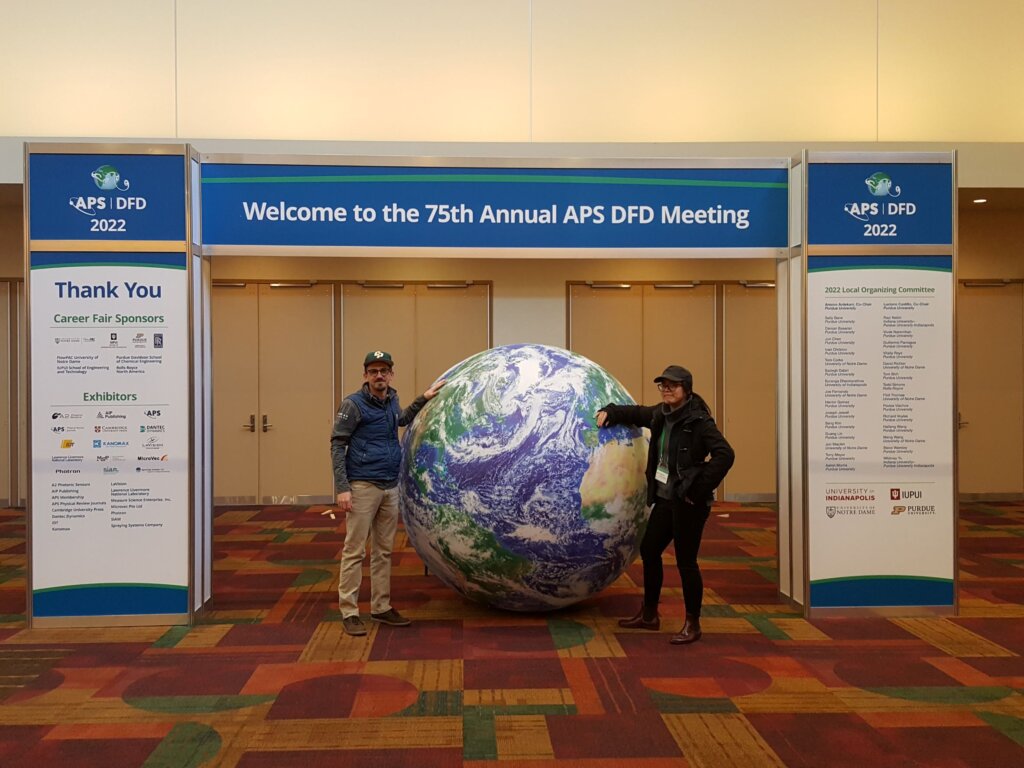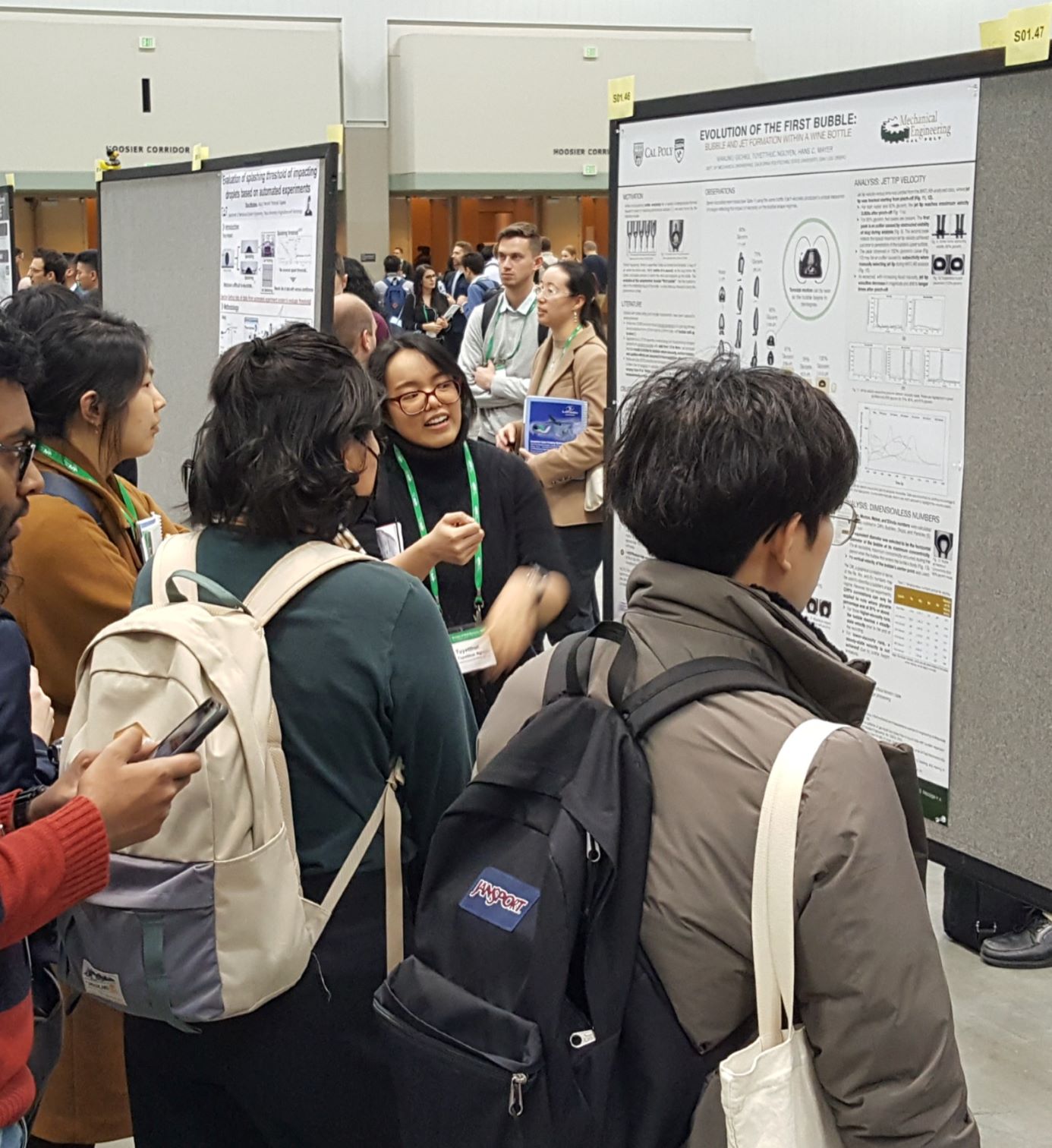Message in a Bottle: Capturing the beauty of the ‘glug’
Mechanical Engineering professor, students win Gallery of Fluid Motion award for video
A Mechanical Engineering professor was so enamored by the evolution of the first bubble that forms from a wine bottle’s glug that he enlisted his Fluids students in a research project to film the phenomenon.
The footage – captured on a high-speed camera and analyzed by Professor Hans Mayer and students Tuyetthuc Nguyen and Wanjiku Gichigi – recently won an award and accolades from the APS Division of Fluid Dynamics.
“I think it is correct to say that we are thrilled with the recognition,” Mayer said.
The video titled “Message in a Bottle: First Bubble High-Speed Imaging” placed in the top three out of 82 entries exploring the beauty of fluids, earning a Gallery of Fluid Motion award at the division’s annual conference which this year took place in Indiana.
Nguyen, of Santa Rosa, and Gichigi, of Fresno, also received first place in the student poster contest for their display highlighting the photography and image analysis around the first bubble.
“I hope that we can inspire others to see the beauty in fluid dynamics, especially when it is something that is in a seemingly mundane and everyday event,” Mayer said. “Who hasn’t ever emptied a bottle and thought about how it glugs, right?”
CONDUCTING THE RESEARCH
For years, Mayer used timed bottle emptying to help students learn about dimensional analysis in his undergraduate fluid mechanics course.
While finishing a research paper in 2019, Mayer wanted a visual to show the difference between a bottle that glugs and the draining of an open tank, so he grabbed a Nikon DSLR to film the glugging.
“I was stunned to see what looked like an absolutely beautiful event,” Mayer said.
He shared an image of the first bubble with Nguyen, who had just completed his Fluids 1 course. She echoed his excitement.
“I knew this was something worth studying further, and we could use this bottle geometry and vary the fluid properties,” Mayer said. “I also wanted to involve students directly and heavily in the project.”
At the start of the 2019-20 academic year, Mayer enlisted students to design and build lighting equipment and frame structure for the setup, but then the COVID-19 pandemic hit and halted most hands-on student research projects.
Work resumed when students returned to campus during the 2021-22 school year.
The Office of University Diversity & Inclusion’s BEACoN program provided Gichigi with financial support and professional development opportunities throughout the project. Mayer also secured department funding to bolster the team’s efforts.
Their first experiment involved filling a cheap wine bottle with water, turning it upside down, then using a high-speed camera to document the evolution of the first bubble as it enters the neck, rises and produces a liquid “jet” before disintegrating.
Nguyen said part of the project’s allure was how simple it was:

“Imagine a person picks up a bottle of ‘Two Buck Chuck’ from an afterparty. The person heads over to the sink and dumps it out. The bottle glugs, and a bubble travels up the bottle. In less than a tenth of a second – faster than the time it takes a person to blink – there’s a lance-like liquid jet piercing the bubble and driving it upwards.
“It’s a stunning phenomenon hidden within an otherwise ordinary object.”
The team then recorded the same process for a range of water-glycerin mixtures, showing how viscosity affects velocity and shapes.
“A large part of why the research produced such great results was because of how well we gelled,” Nguyen said. “It was a dream team because we all shared similar levels of enthusiasm and motivation.”
The team’s approach also exemplified Cal Poly’s Learn by Doing philosophy.
“We have a commitment to student-centered research and this project seemed like a great avenue to get students engaged in fluid dynamics research in a creative way,” Mayer said.
SHARING THE RESULTS
Nguyen, now in her fourth year, developed the poster for the contest based on Mayer’s input and the cumulative research she completed with Gichigi, who graduated in June 2022.
Their poster was hung in the exhibit hall at the Indianapolis Convention Center, where a crowd gathered around Nguyen to ask questions and share observations during a session highlighting the posters.
“A common thread was that a lot of visitors were drawn in by the center visual of the first bubble across different viscosities,” Nguyen said. “Many of the attendees were working on similar research around bubbles and had questions about the analysis process and the results.”
She met a materials engineering student from Korea who had published a book that personified the chemical elements and other researchers from Iran, Japan, France, Germany and Vietnam.
“It was gratifying to be able to share the first bubble transformation with an international community and to likewise be able to see what other kinds of cool fluids phenomena have been observed across the globe,” Nguyen said.
Mayer also encouraged Nguyen and Gichigi to enter Cal Poly’s Art of Engineering Challenge in which students, staff and faculty created visual artifacts to illustrate the relationship between engineering and art.

They used the videos they recorded from the experiments for their entry, “Glycerin Cocktail,” which received the Platinum and Dean’s Appreciation awards and is on display in the Advanced Technology Laboratories.
Through the experience, Nguyen said she learned art and engineering don’t have to be mutually exclusive.
“This project taught me to appreciate how complex and beautiful phenomena can be found in everyday objects, and it taught me how fun it can be to just explore something for curiosity’s sake,” she said.
Gallery of Fluid Motion award winners, including the “Message in a Bottle” video, can be viewed at gfm.aps.org. Additionally, all winners were invited to send a paper about their work for a special collection that will be published next year in Physical Review Fluids.


